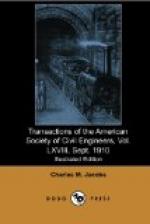Paper No. 1150
THE NEW YORK TUNNEL EXTENSION OF THE PENNSYLVANIA RAILROAD.
By Charles W. Raymond, M. Am. Soc. C. E.[A]
Some time before the appointment of the Board of Engineers which supervised the designing and construction of the New York Tunnel Extension of the Pennsylvania Railroad, the late A. J. Cassatt, then President of the Company, said to the writer that for many years he had been unable to reconcile himself to the idea that a railroad system like the Pennsylvania should be prevented from entering the most important and populous city in the country by a river less than one mile wide. The result of this thought was the tunnel extension project now nearly completed; but it is only in recent years that new conditions have rendered such a solution of the problem practicable as well as desirable.
Previously a tunnel designed for steam railroad traffic, to enter New York City near Christopher Street, was partly constructed, but the work was abandoned for financial reasons. Then plans for a great suspension bridge, to enable all the railroads reaching the west shore of the North River to enter the city at the foot of 23d Street, were carefully worked out by the North River Bridge Company. The Pennsylvania Railroad Company gave this project its support by agreeing to pay its pro rata share for the use of the bridge; but the other railroads declined to participate, and the execution of this plan was not undertaken.
New operating conditions, resulting from the application of electric traction to the movement of heavy railroad trains, which had been used initially in tunnels by the Baltimore and Ohio Railroad and was subsequently studied and adopted by railroads in Europe, made it possible to avoid the difficulty of ventilation connected with steam traction in tunnels, and permitted the use of grades practically prohibitive with the steam locomotive. The practicability of the tunnel extension project finally adopted was thus assured.
The acquisition of the control of the Long Island Railroad by the Pennsylvania Railroad Company, which occurred in 1900, introduced new and important elements into the transportation problem, from a freight as well as a passenger standpoint. Previously, the plans considered had for their only object the establishment of a convenient terminus in New York, to avoid the delays and difficulties involved in the necessity of transporting passengers and freight across the North River. When the Long Island Railroad became practically a part of the Pennsylvania System, it was possible and desirable to extend the project so as to provide, not only for a great prospective local traffic from all parts of Long Island, but also for through passenger and freight traffic to the New England States, and to and from all points on the Pennsylvania System, thus avoiding the long ferriage from Jersey City around the harbor to the Harlem River.




